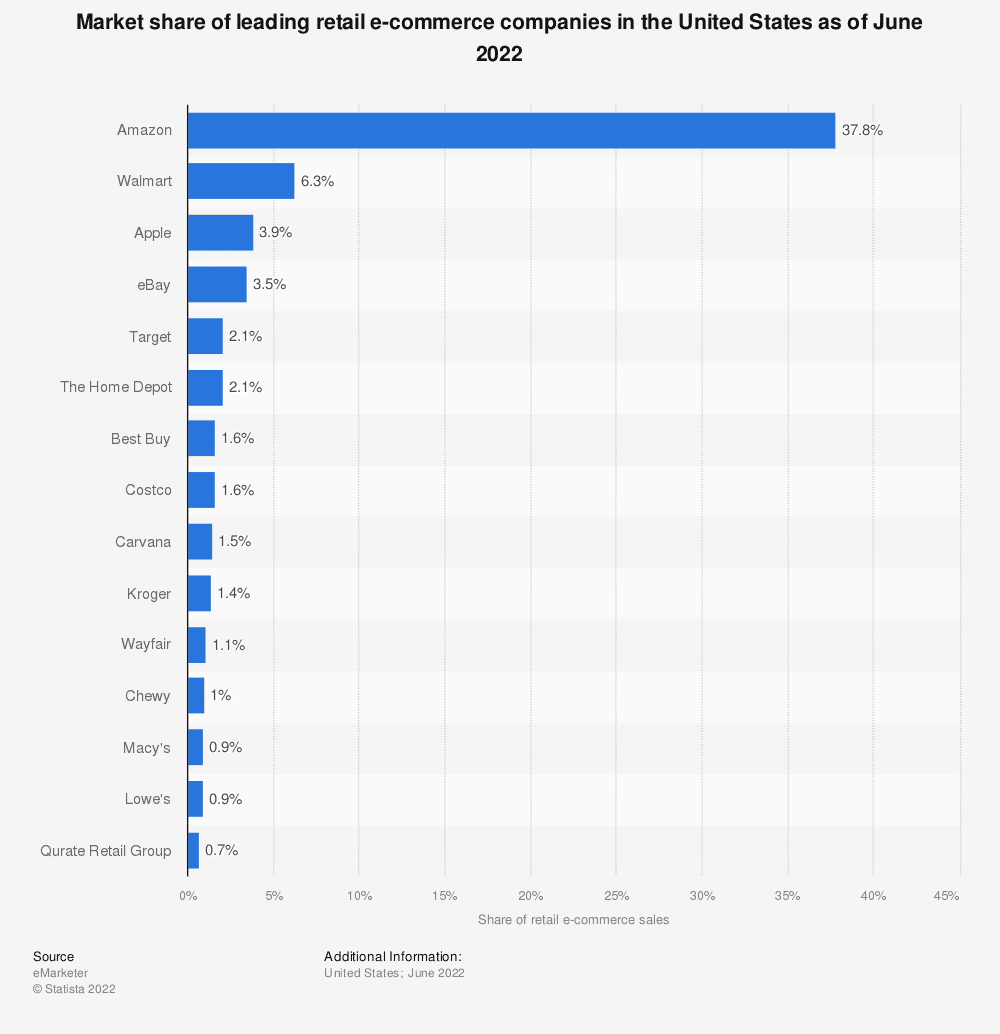Before the COVID-19 outbreak, Walmart was overtaking Amazon as the biggest danger to its business. Since the late 2010s, the firm has made significant investments in Walmart Marketplace, the retailer’s online store. Its online revenue almost doubled after 2020, hitting $43 billion in U.S. sales in 2021.
Amazon vendors looking for new chances will undoubtedly take notice of that kind of accomplishment. But what is selling on Walmart like? What are the main variations, and is it worthwhile to begin?
We compare selling on Walmart vs. Amazon in more detail below. We’ll go over how to Sell on Walmart, what it takes to do so, and how to efficiently take advantage of both markets at once.
Source: Statista
Pros and Cons of Selling on Walmart
Source – Flickr
Walmart Marketplace provides something a little different than what many online vendors are used to on Amazon. One notable difference for Amazon vendors is that there are almost no Walmart selling costs that are, no subscription fees for sellers.
In addition, Walmart Marketplace has fewer vendors than Amazon, which means there is less competition there. This results in somewhat more average page views, although it should be noted that overall, Amazon receives significantly more visitors than Walmart Marketplace. That translates to being a large fish in a tiny pond if you sell on Walmart.com.
In an effort to compete with Amazon’s Fulfillment by Amazon programme, WFS, Walmart likewise started offering it in recent years. Similar to FBA, Walmart’s WFS allows merchants to pay to outsource order fulfilment and returns in an effort to streamline and simplify operations.
When you sell on Walmart.com, WFS comes with two-day shipping and improves your performance with improved search rankings and more Buy Box victories. WFS just levies fees based on the product weight, in contrast to FBA, which levies numerous fulfilment fees.
Personalized account management is one of the best benefits of WFS. A monthly fee of thousands of dollars and a percentage of your sales are required to use that kind of service on Amazon. It’s a nice perk Walmart provides to support their merchants.
The Walmart Marketplace’s biggest drawback may be that not everyone can use it. Applying and getting accepted is one of the prerequisites for selling on Walmart, therefore the low level of competition has a price.
The effectiveness of applicants’ sales, their prior market expertise, and their fulfilment strategies are evaluated. They must also follow Walmart’s sales culture, which requires them to provide cheaper prices than their rivals on Walmart.com and other online marketplaces, in order to be accepted.
Pros and Cons of Amazon Selling
Source – Flickr
Amazon is bigger and more expensive than Walmart.com. With or without FBA, Amazon has more customers and overall more internal traffic, but there are also higher fees.
Since Amazon does not have the same gatekeeping application process as Walmart and draws retailers from all over the world, the competition is substantially tougher on Amazon. Although selling on Amazon involves careful planning and administration, the rewards may be worthwhile. The good news is that there is a tonne of third-party Amazon seller software available to make things considerably simpler.
For a professional account on Amazon, sellers must either pay a monthly fee of $39.99 or $0.99 for each item they sell. In either scenario, additional fees like Amazon’s referral fee still apply to transactions.
Selling on the Walmart Marketplace is far less expensive than doing so on Amazon. The largest built-in customer base of any online marketplace, including Walmart.com, is what you primarily pay for with Amazon.com.
Selling on Amazon and Walmart
The good news is that you don’t have to pick between selling on Walmart and Amazon when it comes down to it. Both are available to you for use!
Although it’s a viable technique, we’re not talking about purchasing from Walmart and selling on Amazon. (Take note that if you do that, you must receive the products before shipping them to customers. The direct shipping of goods to Amazon consumers is prohibited per Amazon’s standards.)
Both sites’ accounts still allow sellers to sell. Although managing two different sales platforms requires twice as much work, the potential profits are double. Playing both sides allows you to practically double your reach because Amazon and Walmart each have their own respective customer bases.
Obviously, expect to do extra work. The Walmart Marketplace features its own advertising platform, Walmart Connect, in addition to basic account management for two markets. Both platforms will require you to handle marketing campaigns.
Selling on Walmart Marketplace shouldn’t be too expensive if you’re already an Amazon seller because there aren’t many fees there. However, you will need to get through the application procedure, even if having a popular Amazon brand will increase your chances of being accepted.
The Million Dollar Question: Selling on Walmart vs. Amazon
A choice that many firms are still debating is whether to sell on Walmart or Amazon. While Amazon used to be the undisputed winner, Walmart has recently started to close the gap.
If you sell on Walmart and Amazon, please share your experiences with us. What is effective for you? What would you change if you could go back in time? Inform us!







